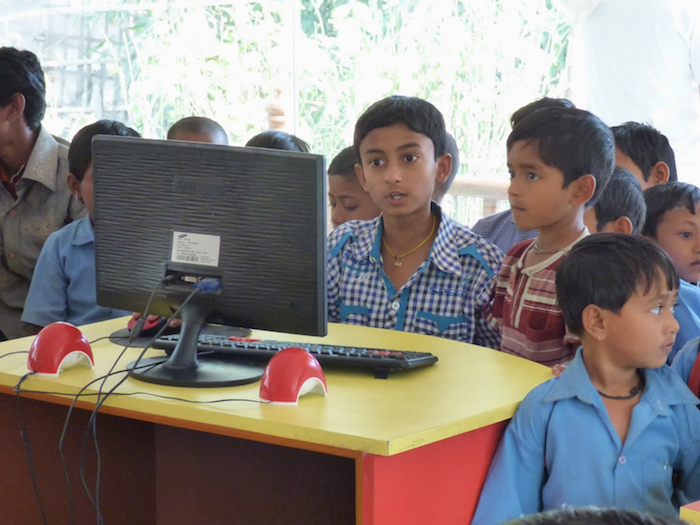
VOL. 6, No. 1
Abstract: This paper examines the effect of the Internet on the reading comprehension of children reading together in groups. First, we describe an experiment to determine if children reading together off the Internet from big screens, can read at a higher comprehension level than children reading the same text alone. The results from this small-sample study are then compared to the results from a larger study across many locations in India. We find that children with low reading comprehension levels to start with can read and understand text at a level higher than expected from them, if they are reading together and have the Internet available. Moreover, in the process of doing this kind of ‘self-organised’ reading, their individual reading comprehension increases. This way of reading may provide a simple and reliable method to improve the reading comprehension of children in their own, or foreign, languages.
Keywords: children, reading comprehension, Internet, collaboration, SOLE.
This paper reports an increase in reading comprehension levels amongst groups of children reading together from text displayed on large, Internet-connected, screens. A series of experiments carried out since 1999 in India, the UK and several other countries hinted at higher than expected reading comprehension in groups of children, when they use the Internet to research answers to a question.
The first, and earliest, of these experiments were carried out between 1999 and 2004. Often called the ‘Hole in the Wall’, these experiments consisted of children in India accessing the Internet, unsupervised and without instruction, through computers embedded into walls in safe, public spaces. The locations were distributed throughout India and included urban, disadvantaged areas as well many rural and remote places. The objectives of these early experiments were to find out if skills required to use computers and the Internet could be acquired by children without instruction (that they could was not known at the time). The results (Mitra & Rana, 2001; Mitra et. al., 2005) indicated that children could learn to use the Internet by themselves and, in the process, seem to learn many other things and certain behavioural traits (Inamdar, 2004; Dolan et al, 2013).
The fact that to do all of this, the children must have been reading and understanding material that was considerably above their expected levels of comprehension, was overlooked!
The ‘Hole in the Wall’ experiments led to the creation of ‘Self Organised Learning Environments’ (SOLEs) through another set of experiments carried out, mainly, in the UK and Uruguay. SOLEs can be set up in schools or any enclosed space and consist of a few computers with fairly large (19 inches or more) screens, connected to the Internet. The screens should be easily visible to anyone in or near the space. Children, about four times as many as there are computers available, are encouraged to research answers to questions. Naturally, they form groups and collaborate, without having to be instructed to do so. The results (Mitra & Crawley, 2014; Mitra & Quiroga, 2012) indicated improvements in learning, the ability of groups to answer questions ahead of their age by many years, and a higher than expected reading comprehension. Once again, we observed reading comprehension in groups that was higher than the individual reading comprehension of any members of the group.
While there are many references to collaborative reading in the literature, there are almost none that factor in the Internet as an assistive tool for reading comprehension.
One study mentions the effects of Internet-based projects on collaborative literacy (Boling Castek, Zawilinski, Barton, & Nierlich, 2011) but does not touch upon the effects on individual comprehension.
A study conducted in Finland describes the nature of collaboration during online reading but does not speak of the mechanism of group reading comprehension (Kiili, Laurinen, Marttunen, & Leu, 2012).
An important paper on how collaborative reading can affect diverse reading needs comes close to what we are looking for but does not include the Internet (O’Brien, 2007).
Reading comprehension in a self-organised learning environment (SOLE) can perhaps be explained by Complex Dynamical Systems (Davis & Sumara, 2006; Haggis, 2008) and Connectivism (Siemens, 2005). On the other hand, it is difficult to interpret with, for example, Project Based Learning (Savery, 2015), Design Thinking (Brown, 2008) or Activity Learning Theory (Engeström, 2001).
The literature does not cover collective, collaborative reading from a big screen. This is not surprising. Reading has been considered a solitary activity, mainly due to the form of printed matter. Books cannot be read together simply because the technology of book production doesn’t lend itself to this. This has resulted in a perception of reading as a solitary activity. It is only recently that it has become possible to show text on a large screen. Even now, due to the previous perception about reading, children (and indeed adults) are all expected to read screens alone. The Hole in the Wall (1999) and the SOLE (2007) were among the first instances where children were required to read and comprehend text in unsupervised groups.
In what follows, we will describe two sets of experiments on the effect of collaborative reading on the Internet, on the English reading comprehension of children.
The first of these experiments is a small-sample study that looks for the possibility of changes in children’s reading comprehension levels due to collaborative reading on the Internet.
The second experiment consists of larger-sample studies carried out across four, widely separated locations in India, where we look for corroboration of the findings of the first experiment.
These experiments look specifically at how groups read using the Internet. Here the groups are using the Internet together in physical space and not online – a common point of confusion when discussing collaboration and the Internet.
Research Question
Does the reading comprehension of children increase as a result of researching topics on the Internet in groups?

Photo 1. Children reading together from the Internet.
This experiment studies whether or not collaborative self-organisation, in the presence of the Internet, can change English reading comprehension. We are looking for any measurable effect on individual reading comprehension in groups of children, using the Internet together, in unsupervised environments.
Our sample consisted of children who can read at, approximately, the UK Key Stage 1 level. In the experiment, they were exposed to material at the UK Key Stage 3 level.
Essentially, our experimental design consisted of dividing a class of 24 children into two groups and then testing them for reading comprehension using individual and group reading exercises. This is described in some detail below as the design is essential for the subsequent interpretation of our results.
Resources Used for Conducting the Experiment
The steps described below were carried out over a period of six school days each in two schools.
Step 1 (90 minutes)
This step provides us with a baseline of reading comprehension for each child.
Step 2 (90 minutes)
Step 3 (90 minutes)
At the end of steps 2 and 3, reading tests 2A and 2B were done by all the children individually and in groups. In effect, the two groups X and Y acted as controls for each other.
Steps 4 and 5 (90 minutes each)
We repeated Steps 2 and 3 with reading Texts 3A and 3B. The reason for doing this was to ensure that any discrepancies in test scores due to the nature of the texts 2A and 2B in the earlier steps would be countered by the equivalent texts, 3A and 3B.
Step 6 (90 minutes)
We repeated Step 1 with the reading test in Text 4 which was chosen to be the same as in Text 1. We did so in order to determine if there had been any changes in the individual reading comprehensions of the children as a result of the collaborative efforts in the steps as described above.
The experiment was conducted in two schools in New Delhi, India, we will call them School 1 and School 2.
School 1 is a private school with students from affluent families with an average annual income of USD 36,000. Most parents work as professionals, academics or business executives. Teachers in this school are from affluent families and are fluent in English.
School 2 is a Government (free) school with students from low-income families with an average annual income of USD 3600. Most parents work as household help, auto rickshaw drivers or government street cleaners. Teachers in this school are from middle income families. They have very poor English skills.
Teachers in both schools get approximately the same salaries.
In choosing the samples, we found that the 10-11-year-old students of School 1 had reading comprehension levels similar to the 13-14-year-old students of School 2.
We chose a sample of 25, 10-11-year-old students from School 1 and another of 24, 13-14-year-old students from School 2. We did so to ensure that the two samples have equivalent reading comprehension levels. In addition, we chose a control group of 24, 10-11-year-old students chosen randomly from School 2, with whom no intervention was done.
When reading in groups, the children were often observed consulting each other and looking up words and sentences on the Internet. They were also seen moving around the room, looking at and questioning other groups and, infrequently, changing groups. The children of School 2 were, in general, more active than the children of School 1. The children of School 1 seemed more possessive of what they had found and less inclined to discuss these findings with others. While they actively discussed within their groups, they never changed groups.
No change was noticed in the control group during this experiment.
The experiment was carried out over a six-day period by two observers in the two schools.
Results
Table 1 shows the results of the experiment.
Table 1. Tabulated Results for the Entire Experiment.
N = 25 aged 10-11yrs |
N = 24 aged 13-14 yrs |
|||
School1 |
School2 |
|||
Step |
Mean |
SD |
Mean |
SD |
1i |
37.75 |
17.43 |
21.42 |
5.78 |
2Ai |
38.21 |
15.09 |
22.27 |
6.53 |
2Ag |
44.79 |
19.54 |
38.02 |
6.31 |
2Bi |
47.96 |
22.10 |
18.32 |
5.81 |
2Bg |
24.48 |
11.73 |
35.42 |
6.51 |
3Ai |
31.72 |
10.15 |
40.89 |
6.92 |
3Ag |
47.92 |
26.35 |
39.58 |
3.61 |
3Bi |
37.50 |
23.47 |
29.38 |
11.78 |
3Bg |
41.67 |
11.52 |
37.50 |
5.41 |
4i |
43.27 |
17.60 |
37.36 |
7.39 |
Here, the letters ‘i’ and ‘g’ are used to denote individual and group reading.
For example, 3Ag means children reading Text 3A in groups. Similarly, 2Bi means children reading Text 2B individually.
We will now discuss these results.
Figure 1 shows the average individual reading comprehension levels at the start and end of the experiment in both schools.
Children in both schools seem to have improved their individual comprehension levels during this six-day experiment. The amount of improvement and, therefore, the statistical significance of the change is noticeably higher in School 2, than in School 1.
Children of School 1 had a higher reading comprehension than School 2 to start with, however, their improvement during the experiment was less than that of the children of School 2. The weaker readers of School 2 seemed to have gained more from the exercise than the more adept readers of School 1.

Figure 1. Reading comprehension at the start and end of the experiment.
Figure 2 compares the reading comprehension of children reading individually and children reading in groups.
Children in School 2 show significantly higher reading comprehension in groups, while children in School 1 show an insignificant difference, indeed, a slightly lower level of comprehension in groups than individually. Children of School 1 were reluctant to work in groups.
Figure 3 shows the average scores obtained by the control group over the same experimental period. No significant change is seen in the scores.
Could it be that the economically disadvantaged children of School 2 were better collaborators and better able to internalise the benefits of collaboration?
Or, is it that the better readers of School 1 were capable of independently improving their reading comprehension and were, therefore, less helped by collaboration?
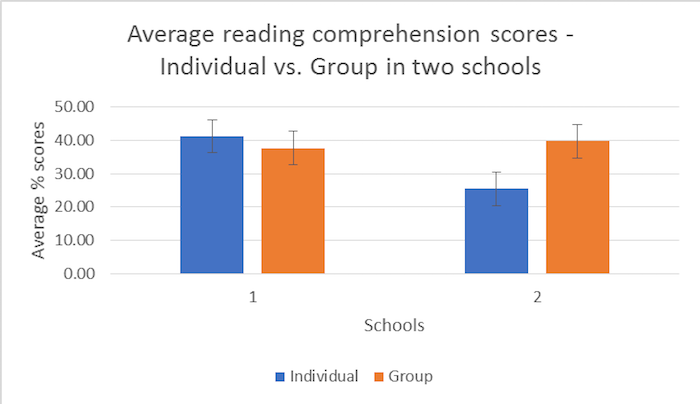
Figure 2. Comparison of individual and group reading comprehension.
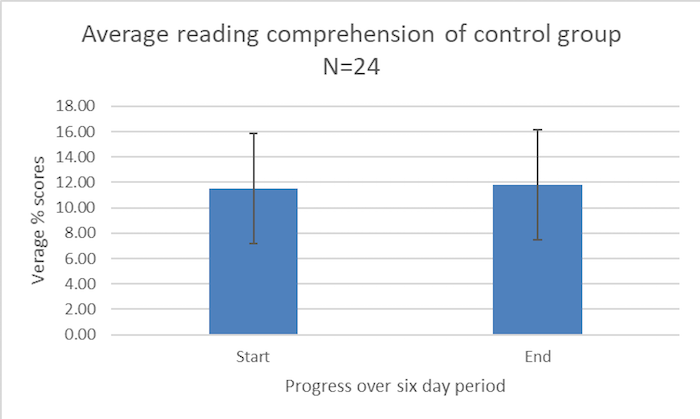
Figure 3. Control group performance.
Finally, children of both schools improved their reading comprehension in the course of the experiment. Could collaborative reading using the Internet be a way to improve reading comprehension?
This experiment, with its small samples, could only raise more questions. We conducted another experiment using larger samples from more varied environments.
During 2014-2017, an experiment was in progress across India and the UK. This experiment called the ‘School in the Cloud’ project was bringing together two concepts – the Self Organised Learning Environment, SOLE (described above earlier), and the ‘Granny Cloud’.
The ‘Granny Cloud’ is a group of volunteers, consisting of people who have access to the Internet, a web camera and can use the Internet and, particularly, Skype video conferencing. The Granny Cloud was created in 2009 when it was noticed that the progress made by children when learning in SOLEs, is heightened by the presence of a friendly and not necessarily knowledgeable adult who encourages and admires their efforts (Mitra, 2009). The word ‘Granny’ is not to be taken literally. It is based on the social stereotype of grandparents. It was, indeed, a name suggested by Indian children, whose view (as indeed the views of most children worldwide) of a grandparent is that of a friendly, well-meaning, admiring and amusing adult. Members of the Granny Cloud interact remotely with children using Skype, about once a week for an hour with each group of children.
Seven facilities for children had been set up – five in India ranging from very remote and poor areas to villages and small towns, where middle class income families live. Two facilities were also set up in England, one in an urban and the other in a rural setting. Of the seven, four including the sites in England were inside schools, while three were in a stand-alone, community setting.
Each site was an enclosed space, with at least two clear glass walls, containing between six and eight computers with large screens. Each computer had seating for several children in front of the screen. Each facility also had a larger screen for Skyping with the Granny Cloud. Photo 1 shows one of these sites.
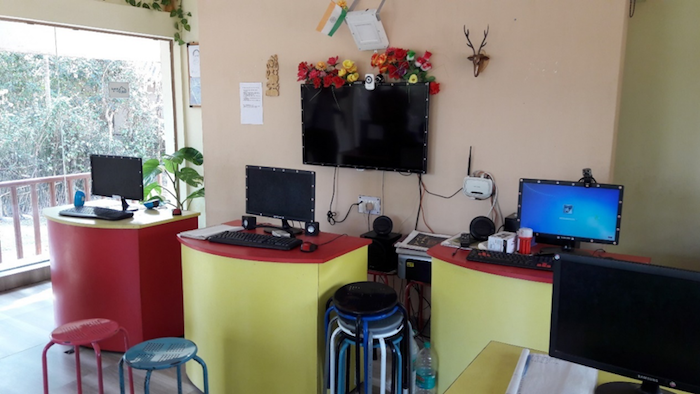
Photo 2. A school in the cloud facility.
These facilities were used by children, usually below the age of 15, with a teacher (when in a school) or a local coordinator (when in a community setting) present. The children would research a question (often called a ‘Big Question’) by themselves. Or they could engage in whatever activity they chose to. There was no ‘supervision’ or ‘guidance’ from any adult present. Sometimes, the question would be posed by the Granny Cloud.
The School in the Cloud project was measuring the effect of SOLEs and the Granny Cloud on children in five locations in India, ranging from the very remote (and very poor) to the urban middle class. Among many of the things that the School in the Cloud project was measuring, was English reading comprehension. Three of the five locations were in the Bengal region of India and one each in North and West India.
Of the five sites, two were in schools where English was taught by teachers with very poor English skills. The other three sites were in community settings where the children were taught very little English in local vernacular schools by teachers, when they could be found. As far as reading comprehension goes, the children in all the sites could be compared, in spite of the large socio-economic differences in these communities.
It is not possible to find control groups in such settings, as it is not possible, nor right, to prevent children from coming to the School in the Cloud.
Neither was it possible to remove the influence of teachers, no matter how unsatisfactory, on the children’s reading comprehension.
While it was not possible to isolate the influence of teachers or the influence of the School in the Cloud independently, it is possible to approximately deduce the two influences from the data.
In one of the schools, baseline measurements were done in Grades 2, 3, 4, 5 and 6 at the start of the experiment. These are shown in Figure 4. Approximately, 100 children were distributed over these grades. These children came from a lower, middle-class Indian background. Their native language was not English and they were taught English by teachers with poor English language skills.
Since each grade would transition to the next grade in a year, we can use Figure 4 to estimate the effect of traditional teaching on reading comprehension. For example, if the baseline score for Grade 3 is 22.0% and that of Grade 4 is 43.6%, we can estimate that, on average, an increase of 21.4 percent (i.e., 43.6-22.0) could be expected without any intervention in addition to the usual teaching and learning practices in the school. We can then take the actual reading comprehension score for year 3 at the end of the experiment, reduce it linearly to an annual rate and compare this with the expected score. We can do this for each of the grades except Grade 6, since the baseline data for Grade 7 is not available. The results are shown in Figure 5.
While our estimation of expected scores does not consider the intrinsic differences that may exist between the children of one grade and another, it does provide us with a way to estimate, on average, what increases the teaching process may produce.
Figure 5, then, shows us that, except for very young children, 7-year-olds, of Grade 2, the introduction of the School in the Cloud facility into this school consistently produced higher than expected levels of reading comprehension.
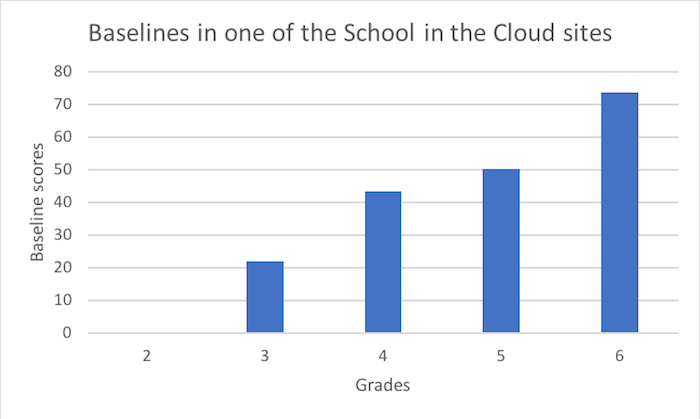
Figure 4. Baseline scores at the beginning of the
School in the Cloud project.
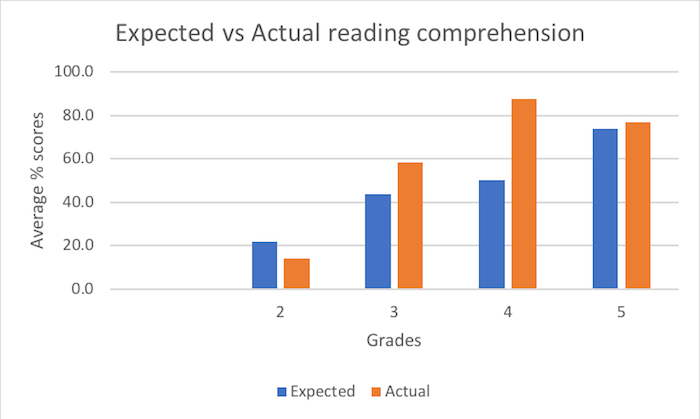
Figure 5. Anticipated scores based on the next grade’s baseline as an estimate of expected score for a grade, vs. their actual scores.
However, the conclusion above can be challenged by an unresolved issue. The School in the Cloud is a combination of two ideas – SOLEs and the Granny Cloud. Although the data in Figure 5 shows us that the School in the Cloud does increase reading comprehension significantly, there is no way to tell what the relative contributions of SOLE sessions and Granny sessions contributed to this increase. The children in the school studied in Figure 5 were exposed to about one hour of interaction with a native English speaker every week. To isolate the effect of these sessions on reading comprehension, we would need a facility where the children do SOLE sessions but do not have access to any Granny sessions. We do not have such data. We can only conjecture that Granny sessions emphasise listening and speaking more than reading, while SOLE sessions are, almost exclusively, about reading. Maybe, it is SOLEs that contribute more to the increase in reading comprehension. Children making sense of text that is not designed for anybody in particular, are likely to improve their comprehension over time. This conjecture is supported by the ‘Hole in the Wall’ experiments (1999-2005), which were conducted before the Granny Cloud idea was implemented.
We may, finally, have found a clue to the high levels of reading comprehension observed in the Hole in the Wall experiments (Mitra & Rana, 2001; Mitra et. al., 2005).
The School in the Cloud project was measuring reading comprehension in random samples of children at each experimental site at intervals of one month. These measurements were done with each individual child in the sample. These children were all reading in groups all the time in their School in the Cloud facilities. We decided to check if the data from these measurements had any similarity with the data from our first experiment described above.
The School in the Cloud project was using ASER tests, developed in India and widely used in the last decade. These tests are well validated (Vagh, 2012) and are based on the Early Grade Reading Assessment (EGRA) developed in the USA and well validated and used (RTI International, 2016).
The UK SAT tests that we used in the experiment above are also periodically validated against parameters like those used in the ASER and EGRA tests (OFQUAL, 2017).
We decided that ASER and SAT tests were measuring the same abilities. However, scores from ASER and SAT cannot be compared numerically due to the different way in which the scores are computed.
Our purpose in comparing the present data with that from the School in the Cloud project is not to use the absolute scores but to compare the changes in reading comprehension between individual and group reading settings.
The results from the present experiment suggest that the reading comprehension of children reading from the Internet in groups affects their individual reading comprehensions over time. If so, we should see evidence of this in the reading comprehension measurements from the School in the Cloud project.
Figure 6 shows reading comprehension scores measured over an approximate three-year period from seven samples taken from four sites in India where the School in the Cloud project took place.
We can see from Figure 6 that there is a clear increase in reading comprehension over the two-year period shown in Figure 6. During this period, some of the children (about 100 from the total sample) were taught English, usually by teachers with very poor English skills. The rest were not taught any English at all.
Within the sample shown in Figure 6, is a school where the children were already familiar with the SOLE method and had been using the Internet for about one year prior to the experiment. Their English reading comprehension was already quite high at the start of the measurement (here we are referring to the School in the Cloud project and not the first experiment described above). Our experiment suggests that these children’s reading comprehension should have improved less rapidly than that of children who had a lower starting comprehension level.
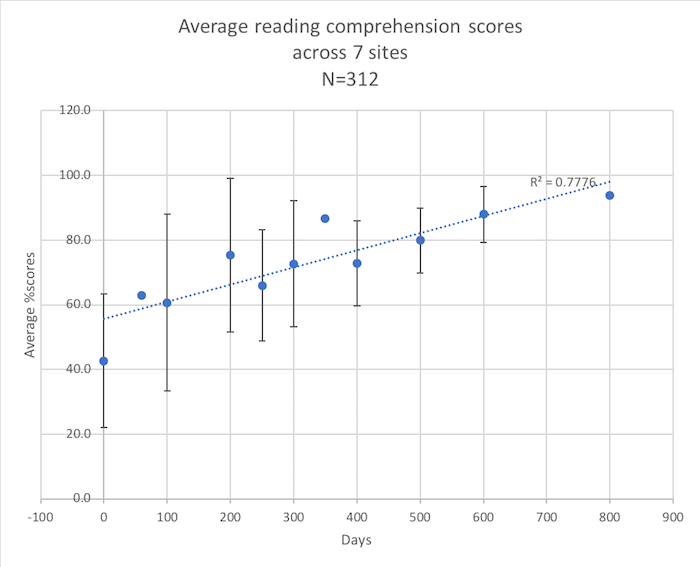
Figure 6. Average Individual reading comprehension scores over time.
Within the sample shown in Figure 6, is a School in the Cloud facility in a remote area where the children started with a low reading comprehension. Our first experiment suggests that these children’s reading comprehension should have improved more rapidly than that of the children starting at a higher comprehension level.
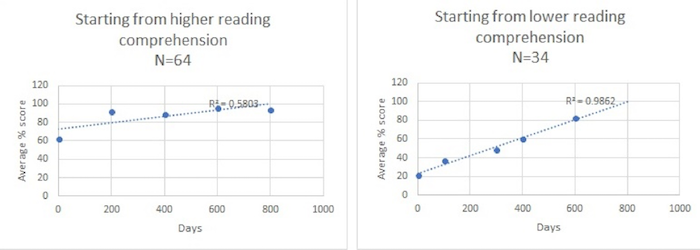
Figure 7. Effect of group reading off the Internet on children with higher and lower starting abilities.
We find, from Figure 7 that the children starting with lower reading comprehension ability improve faster than those with a higher starting ability. This agrees with findings from our experiment as reported in Figure 2.
We have compared the results from the present experiment with those from the School in the Cloud project. The two sets of data seem to agree with each other in a number of ways. We summarise these findings below:
These findings are easily useable in the classroom. This may provide teachers with an easy method to improve reading comprehension in children, whether in their own language, or in a foreign language. Indeed, teachers have been using SOLEs in their classrooms all over the world, since about 2010 (see for example, https://startsole.org/).
These experiments do not tell us what causes this increase in reading comprehension in collaborative groups in the presence of the Internet. However, the four points above, particularly the fourth, are similar to ‘flocking’, ‘murmuration’ and other self-organising behaviour in the animal and insect world. The self-organised learning environments (SOLEs) created in the experiments described in this paper are highly connected systems, connected through shared experience and conversation.
Could the observations and data above be a result of ‘spontaneous order’ appearing in a complex dynamical system? (See, for example, Arenas Díaz-Guilera, Kurths, Moreno, & Zhoug, 2008.)
Future experiments may throw light on this intriguing possibility.
Acknowledgements
The author is grateful to Ritu Dangwal and Suneeta Kulkarni for coordinating and directing the collection of data. Thanks also to Minerva Thounaojam and Krati Sharma for help with the data collection. Considerable help was obtained from a literature survey carried out by Natalia Vega.
The School in the Cloud project was funded using the TED Prize of 2013 from www.TED.com. This was not a research grant. The prize funds were donated for this project by the recipient.
Administrative help from NIIT limited is gratefully acknowledged.
Brief discussions with Nicholas Negroponte (MIT, USA) and Marianne Wolf (Tufts, USA) helped shape some of the ideas in this paper.
Finally, a conversation, short and scintillating, with the late Professor Seymour Papert remains a cherished memory.
Arenas, A., Díaz-Guilera, A., Kurths, J., Moreno, Y., & Zhoug, C. (2008). Synchronization in complex networks. Physics Reports, 469(3), 93-153. Retrieved from https://doi.org/10.1016/j.physrep.2008.09.002
Boling, E., Castek, J., Zawilinski, L., Barton, K., & Nierlich, T. (2011). Collaborative literacy. Blog. Retrieved from https://ila.onlinelibrary.wiley.com/doi/full/10.1598/RT.61.6.10
Brown, T. (2008). Definitions of design thinking. Harvard Business Review, 86(6), 84-92, 141.
Davis, B., & Sumara, D. (2006). Complexity and education inquiries into learning, teaching, and research. Hoboken: Lawrence Erlbaum Associates.
Dolan, P., Leat, D., Mazzoli Smith, L., Mitra, S., Todd, L., & Wall, K. (2013). Self-organised Learning Environments (SOLEs) in an English school: An example of transformative pedagogy? Online Education Research Journal, 3(11) 1-19.
Engeström, Y. (2001). Expansive learning at work: Toward an activity theoretical reconceptualization. Journal of Education and Work, 14(1), 133-156.
Haggis, T. (2008). Knowledge must be contextual: Some possible implications of complexity and dynamic systems theories for educational research. Educational Philosophy and Theory, 40(1), 158-176.
Inamdar, P. (2004). Computer skills development by children using “Hole in the Wall” facilities in rural India. Australasian Journal of Educational Technology, 20(3), 337-350.
Kiili, C., Laurinen, L., Marttunen, K., & Leu, D.J. (2012). Working on understanding during collaborative online reading. Journal of Literacy Research, 44(4), 448-483.
Mitra, S., Dangwal, R., Chatterjee, S., Jha, S., Bisht, R., & Kapur, P. (2005). Acquisition of computing literacy on shared public computers: Children and the “Hole in the Wall”. Australasian Journal of Educational Technology, 21(3), 407-426.
Mitra, S., & Rana, V. (2001). Children and the Internet: Experiments with minimally invasive education in India. The British Journal of Educational Technology, 32(2), 221-232.
Mitra, S., & Crawley, E. (2014). Effectiveness of self-organised learning by children: Gateshead experiments. Journal of Education and Human Development, 3(3), 79-88.
Mitra, S., & Quiroga, M. (2012). Children and the Internet: A preliminary study in Uruguay. International Journal of Humanities and Social Science, 2(15), 123–129.
Mitra, S. (2009). Remote presence: Technologies for 'beaming' teachers where they cannot go. Journal of Emerging Technology and Web Intelligence, 1(1), 55-59. Retrieved from http://www.academypublisher.com/jetwi/vol1/no1/jetwi01015559.pdf
O'Brien, C. (2007). Using collaborative reading groups to accommodate diverse learning and behavior needs in the general education classroom. Beyond Behavior, 16(3), 7-15.
OFQUAL (2017). Content validation study – 2016 of key stage 2 English and Maths tests. Retrieved from https://www.gov.uk/government/publications/content-validation-study-2016-key-stage-2-english-and-maths-tests
RTI International (2016). Early grade reading assessment. Retrieved from https://globalreadingnetwork.net/resources/early-grade-reading-assessment-egra-toolkit-second-edition
Savery, J.R. (2015). Overview of problem-based learning: Definitions and distinctions. In A. Walker, H. Leary, C. Hmelo-Silver, & P. A. Ertmer (Eds.), Essential readings in problem-based learning: Exploring and extending the legacy of Howard S. Barrows, (pp. 5-15). Purdue University Press.
Siemens, G. (2005). Connectivism: A learning theory for the digital age. International Journal of Instructional Technology and Distance Learning, 2(1), 3-10.
Trucano, M. (2012). Evaluating One-Laptop-Per-Child (OLPC) in Peru. Retrieved from http://blogs.worldbank.org/edutech/node/654
Vagh, S.B. (2012). Validating the ASER testing tools. Retrieved from http://img.asercentre.org/docs/Aser%20survey/Tools%20validating_the_aser_testing_tools__oct_2012__2.pdf
Author:
Dr. Sugata Mitra retired in February 2019 as Professor of Educational Technology at the School of Education, Communication and Language Sciences at Newcastle University, UK. He received the $1m TED Prize in 2013 in recognition of his work and to help build a School in the Cloud, a creative online space where children from all over the world can gather to answer 'big questions', share knowledge and benefit from help and guidance from online educators. The School in the Cloud brings together Self Organised Learning Environments (SOLEs) to link in with the Granny Cloud, originally set up in 2009 following an appeal for retired teachers willing to offer a few hours a week to help teach English to Indian school children. This mentoring and encouraging role is still a vital part of the success of this educational approach today. Email: sugata.mitra@gmail.com
Cite this paper as: Mitra, S. (2019). Does Collaborative Use of the Internet Affect Reading Comprehension in Children? Journal of Learning for Development, 6(1), 20-36.